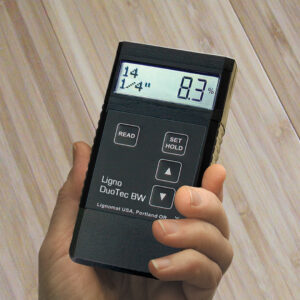Measuring Moisture in Bamboo Flooring
 Bamboo is a hygroscopic material just like wood. It will absorb moisture and expand with high levels of humidity in air and loose moisture and contract when the relative humidity surrounding the bamboo is low. Therefore, measuring the moisture in bamboo flooring is an important task for the floor installer to avoid problems with shrinking or expansion.
Bamboo is a hygroscopic material just like wood. It will absorb moisture and expand with high levels of humidity in air and loose moisture and contract when the relative humidity surrounding the bamboo is low. Therefore, measuring the moisture in bamboo flooring is an important task for the floor installer to avoid problems with shrinking or expansion.
Lignomat offers pin and pinless meters with bamboo-specific calibrations. The bamboo corrections are programmed in the pinless moisture meters Ligno-Scanners SDM, Ligno-DuoTec BW and Ligno-VersaTec. The pin moisture meters mini-Ligno DX, DX/C, Lignometer K and Ligno-VersaTec can also be used with the Electrode E14 for measuring moisture in bamboo.
When bamboo was introduced to the flooring industry years ago, we started extensive testing to measure the moisture in bamboo flooring with wood moisture meters. We found new “wood groups” for the pin meters. For the pinless meters, we had to add a new set of correction curves, which were different from corrections for wood species. We added those correction curves to our SDM, BW and VersaTec meters. As a special service, SDM, BW and VersaTec meters, which are not set up for bamboo yet can be up-dated. Call customer service at 800-227-2105.
Correction factors for wood moisture meters are based on oven dry testing of wood samples of the same species at different moisture levels. To establish correction factors for this new, non-wood bamboo flooring material, we acclimated bamboo sample boards to different relative humidity levels starting at 80% and going down to 25%.
Next, we performed oven tests on these samples. We used the same oven dry method for the bamboo floor samples as if we wanted to calibrate the meter for a new wood species. The moisture contents we calculated from the oven dry samples were always too low. For example, an oven test for a bamboo floor sample acclimated to 45% relative humidity gave 5%. Therefore, we did not base the calibration for bamboo on the oven-test results, but we choose to use the WME moisture percentages coming from the relative humidity the samples were acclimated to. The WME value for the sample board acclimated to 45% was 8.5% according to the EMC chart. For a bamboo flooring piece acclimated to 80% relative humidity, a moisture value of 16% can be found using the EMC chart. For each relative humidity value a stable wood moisture content is listed on the EMC chart. For materials other than wood that value is called WME or wood moisture equivalent.
The advantage of these WME moisture percentages for bamboo flooring is, that the floor contractor knows from experience that wood floors are stable at 6-9 percent moisture content, which corresponds to a relative humidity of 30-50%. So, bamboo floors at 6-9% measured with one of Lignomat’s meters using the bamboo calibration are also stable at 6-9%.
Summary: Using a meter from Lignomat with bamboo calibrations is easy. Find the right bamboo calibration setting on the wood group chart or from the bamboo manufacturer’s web-site. Dial the bamboo setting and all moisture percentages can be directly compared to wood floor moisture percentages.
For instance, if our meters indicate 8.5% for a bamboo floor, the floor is stable in a 45% relative humidity environment just as if it were wood at 8.5%. (See EMC chart)
Lignomat offers to test solid and engineered bamboo products to determine a setting for Lignomat meters to obtain WME moisture percentages (percentages which can be compared to wood moisture percentages).

